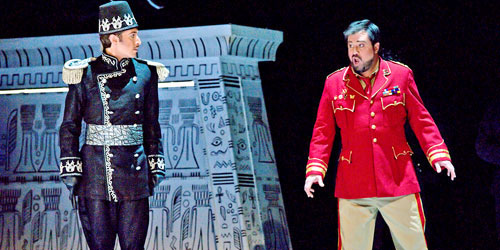By Michael H. Margolin

Sitting down to report on Michigan Opera Theatre's production of "Giulio Cesar in Egitto" (though given the shortened, Shakespearean title, sung in Italian with surtitles) I grabbed for my list of superlatives, and came up with: brilliant, stellar, primo, corking and the ever-popular, fantabulous.
It was so satisfying an experience that when it was over I wanted to light up a cigarette.
To begin with, the production, originated by Houston Grand Opera in 2003 and revived in 2007, is a miracle of stylization and delight: Scenic drama is created with lights (Adam Greene) or with moveable palm trees or backlight cutout figures (Christine Jones), and the characters are dressed in the most marvelous costumes (James Schuette) with fine hair and makeup (Cindy Ludwig). The end of Act I is the big production number we have come to expect in Broadway musicals, but it is intrinsic to the opera and not just a directorial whim.
The opera debuted in 1724 and became Handel's biggest hit among his some 40 operas. It is set in ancient times when Caesar and Cleopatra, Egypt's dynamic ruler-to-be, meet, discharge their enemies, and cozy up for a hot affair. Re-imagined on a movie set of the 1930s, tails and top hats and slinky gowns mesh with other genre outfits such as a silk robe and the Balkan-style dictator outfit for Tolomeo, her brother and nemesis.
All of the above is perfectly consistent with opera seria for the 21st century; opera seria, often known as Baroque, is a form of opera that dominated Europe during the 17th and 18th centuries. Usually dealing with heroes, kings and villains, the plots, aria after aria with recitative (sung speaking) in between, is the dominant style. There is no separate chorus, and few, if any, duets. The idea was to hear the music and your favorite singer, the plot being only the hanger for the composers weave of melody (and this opera's are sensational) and, of course, the singers' bravura talents. Think of "Glee" with royalty.
So there is, of course, a happy ending – though death, villainy and treachery lead up to that. And all of the characters, including those who have died, come together for the final chorus and go to the seashore – well, actually, to the movies – providing one of the most wonderful final tableau of any opera I have seen.
High praise goes to Michael Shell who directs the show based on Houston's, finding ways to keep it from falling into just stand and sing. In what is relatively static, he has cleverly blended the actors, the music and the drama into a constant pleasure for an audience.
In the pit, Maestro Howard Arman led a group of musicians consistent with the orchestra of the time: horns, trumpets, strings and, of course, the harpsichord, with its distinct sound, which accompanies recitatives as well. Singers and orchestra blended like bees and honey.
The singing was of the highest quality throughout, starting with David Daniels, the great vocal inspiration to a new generation of singers. He describes himself as a male alto; his vocal type is usually called countertenor.
In any case, his voice is very beautiful, sensuous, with shining high notes and warm tones in the middle. He is a consummate actor, using body English as if it were Italian; he can simmer, he can caper and he can enthrall. (He sang the role in Houston's production.)
There are, besides Daniels, two countertenors in this version. (The fourth, David Trudgen will sing the eponymous role twice during the run.) Anthony Roth Costanzo plays Tolomeo, the spoiled brat brother of Cleopatra, with peevishness and fury. His second act aria was a bravura rendition, voice powerful and pitched perfectly; he is a rising star. Eric Jurenas as Nireno showed a clear and supple voice in the other countertenor role.
Most of the singers are making debuts with MOT: Lisette Oropesa was the Cleopatra (to be sung by Andriana Chuchman, who impressed in last season's "Figaro", in the alternate cast). Her voice is like elastic: She produced thrilling trills and staccato high notes, and her slim, graceful body performed eloquently – especially in her "victory" dance when she learns her rotten brother is dead and Caesar is alive.
Other singers were impressive. In the role of Sesto, mezzo soprano Emily Fons made a major impact with her gleaming voice; she sang the role of Cornelia's son with great passion. As Cornelia, the Roman widow of murdered Pompeo, Allyson McHardy has a major mezzo voice with great color and warmth. With this much talent in the two vocalists, it was regrettable that much of their music was cut – often the case in modern practice when the score can run four hours. (My recording is four hours and five minutes.) Still, the show came in 10 minutes under the announced timing.
Rounding out the cast was Timothy Bruno, young artist apprentice, effective as Curio, and Christopher Temporelli as the nasty Achille, who redeems his character; he sang with warmth and presence.
Finally, Laura Leigh Roelofs played the violin accompaniment, on stage, to one of Caesar's arias, with panache.
Given the enthusiasm of the audience (with many more than I often see of the under 40 crowd), MOT should think about obtaining Houston's production of "The Coronation of Poppea," Monteverdi's great 1642 opera.
REVIEW:
'Julius Caesar'
Michigan Opera Theatre at Detroit Opera House, 1526 Broadway St., Detroit. 7:30 p.m. Nov. 14, 16 & 17 and 2:30 p.m. Nov. 18. 3 hours, 5 minutes. $25-125. 313-237-SING. http://www.Motopera.org










